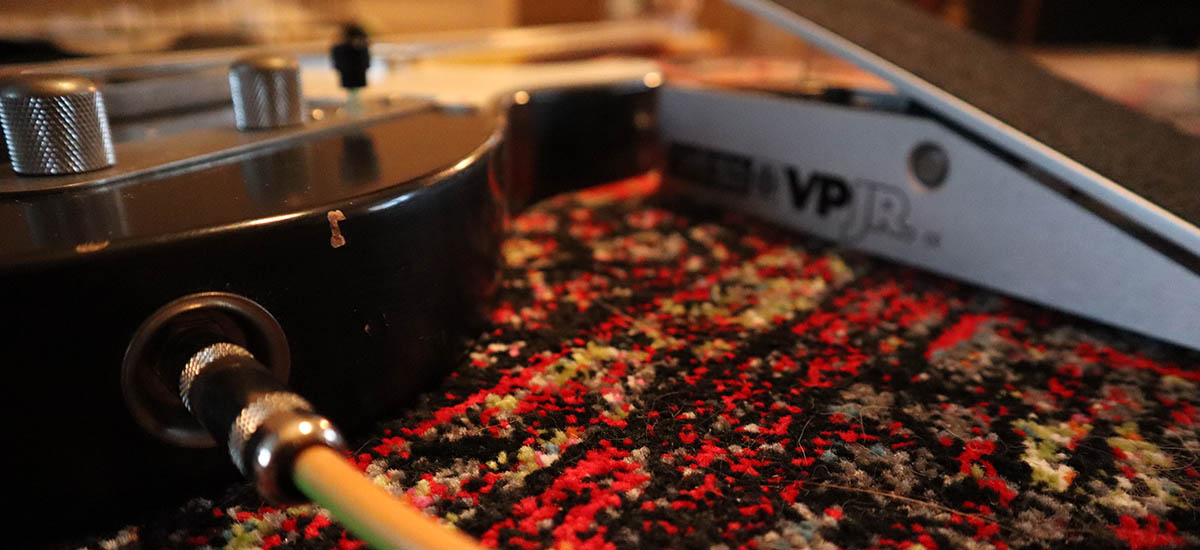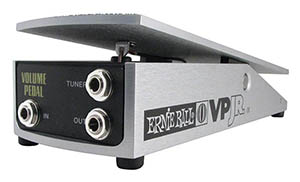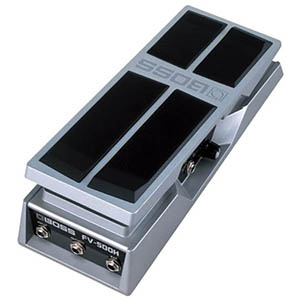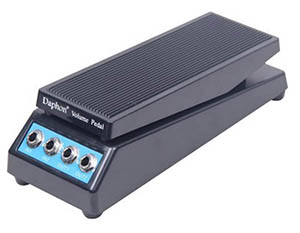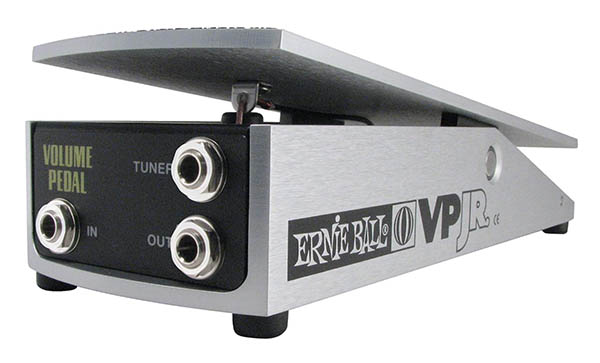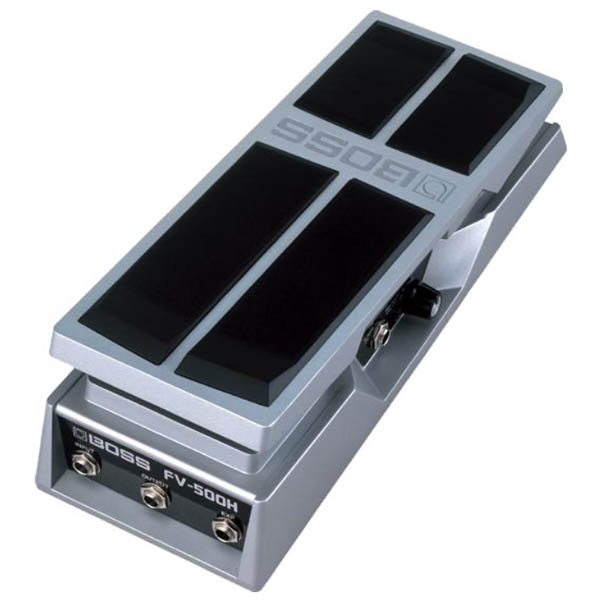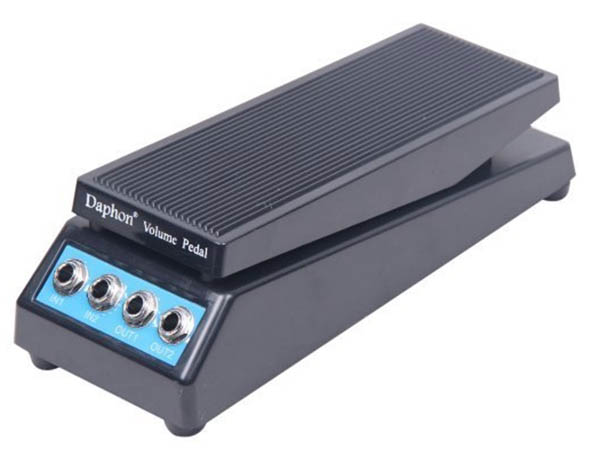A volume pedal is one of the most underrated tools a guitarist can utilize both for live performance where efficiency and professionalism matter, and in crafting the perfect sound that gets the most out of your entire rig. Every single guitar player should have a volume pedal on their pedal board, it’s that important. Our favorite is the Ernie Ball VP Jr. This is a beefy pedal built for maximum durability, premium construction, and perfect functionality.
Table of Contents
Our Picks at a Glance
The Ernie Ball VP JR Volume pedal is the most ubiquitous and often seen volume pedals for a reason. Its bulletproof construction without unnecessary bulkiness makes this pedal easy to fit on almost any pedalboard. The VP Jr. has mono in and out with the option of an “always on” output to a tuner pedal. It contains the perfect balance of simplicity, features, construction, and feel that make this pedal an absolute must. Add this volume pedal to your pedalboard and unlock the full range of sounds all the combinations of your pedals have to offer. Jump to the full review.
Another volume pedal with nearly as much exposure as the Ernie Ball VP Jr is the Boss FV-500H. This is another great standby that has withstood the test of time and is a great investment for a guitar player looking for a great volume pedal. This pedal is a bit more bulky than the Ernie Ball, which puts it second on our list. The Boss is a full featured volume pedal that emphasizes durability, a must have priority when considering a high use piece of gear like a volume pedal. Jump to the full review.
When Amazon’s Choice is a volume pedal from a random electronics company that costs less than $30, we at least have to take a look. This surprised us as a decent pedal for someone on a budget who may not need the heavy duty construction of the Ernie Ball or the Boss volume pedals. It is slightly more bulky than the Ernie Ball, doesn’t have a tuner out, and lacks both in the smooth action and construction departments. But I would recommend this pedal for someone on a budget as it performs the functions of a volume pedal and is the cheapest option on the market. Jump to the full review.
What is a Guitar Volume Pedal Used For?
Take a look at my article: The Volume Knob – The Guitar’s Best Kept Secret for an in-depth look at the importance of being able to vary the volume coming out of the guitar. Volume pedals similarly vary the output in the signal chain that gets passed along.
While the guitar’s volume knob plays the role of deciding how much pickup voltage makes it out of the guitar, a volume pedal can be placed in different spots to get different sounds out of effect pedals, processors, and amps. Jump to where to place a volume pedal in the signal chain.
In the article about the guitar’s volume knob, I talk quite a bit about a volume swell technique called violining. This effect comes from plucking a note and then swelling the volume quickly with the guitar’s volume knob can also be done with a volume pedal. In fact, many guitar players opt for using a pedal for this type of effect. One of the main reasons is that a guitar’s volume knob may not be in reach.
For example, a Strat’s volume knob is in the perfect spot to pluck the note and manipulate the knob with the pinky finger. It takes some practice to get a smooth swell with your pinky, but can be a very unique and rewarding arrow to put in your guitar quiver.
However, a Les Paul or 335’s volume knob is just too far away to be able to use this same technique. For that reason a volume pedal becomes necessary for smooth volume swells that come immediately after a note is plucked.
Sidechain emulation on guitar
This is one of the cooler uses of volume pedal that I’ve come across recently and Adam Neely does a great job of describing what it is and showing an example in the context of an orchestration that he wrote. Check it out in the video below.
This effect emulates a sidechain compressor which is used often in electronic music to “duck” the volume of a track based on the kick of the drum track. This creates a pulsing effect that gives the song a strong driving sense.
This technique requires practice to get the timing of the swells perfectly in tune with the tempo of the song, but can provide a really cool effect that can add a lot of depth to the music you’re playing along with.
Silent Tuning
One of the signs of a professional musician is never tuning an electric guitar out loud. While most tuning pedals have a mute mode when switched on, it can be incredibly handy to plug into the always on jack of your tuner so you can see if you’re in tune during a song without completely muting yourself.
If you’re planning on playing live, a volume pedal with a tuner out is the best way to go. The tuner always stays on, and the volume pedal sends a full signal to the tuner at all times, bypassing the pot in the volume pedal.
This is also important if you’re trying to keep your effects rig free of buffers. Most tuning pedals are going to buffer your output while sending a signal from the volume pedal that dead-ends at the tuner preserves your buffer-free signal.
Switching Guitars or Instruments
This is another professionalism gripe, but if you’re playing live you should have a way to swap guitars that is efficient, seamless, and doesn’t subject the audience to the sound of a hot jack being pulled out of a guitar.
The song is over, kick your volume pedal to mute, swap guitars and you’re all set. Again, if you’re playing live and have more than one guitar then a volume pedal is an absolute must.
Volume Pedal Features
Construction
Volume pedals are one of the higher use and impact pieces of gear that exist on your rig. Many guitar players with one will use it to some extent on every single song. If you’re using your volume pedal frequently you’ll want something that can stand up to the abuse.
Quality volume pedals will be made of metal and are generally made from milled or cast aluminum with strong steel pivot bars. While plastic pedals are generally effective in delivering the functionality of a volume pedal, metal construction will last a very long time and is the recommended choice for most players.
Action
The action of the pedal describes how smooth and how much force is required to move the pedal back and forth. A quality pedal will feel incredibly smooth and not move once set in a specific spot. This is an immediate disqualifier if a pedal moves at all after setting it.
Smooth action speaks to the construction and quality of the bushings and string or cable mechanisms.
The techniques described above are only achieved through precise muscle control of the foot. This becomes much much harder if a pedal doesn’t provide decent resistance and smooth control.
Mono Vs. Stereo
Mono volume pedals will generally have a single input and a single output, while stereo pedals will have two inputs and two outputs. It’s important to note that not every pedal is designed to take a mono input and spit to stereo, or take a stereo and sum to mono. Pay close attention to the details of the pedal and determine if it really meets your needs.
Pedals with two inputs and two outputs like the Signstek support two independent channels, which works if you already have a stereo signal, but will not split a mono input into a stereo output.
Volume Vs. Panning
Another cool feature that really makes this its own category are pedals that allow for stereo panning. All pedals reviewed in this article do not have panning capabilities, but check out the Ernie Ball panning pedal for an awesome pedal that can create some wild effects if you’re running a stereo setup.
This can be a really cool effect where your mono signal is split into stereo, left and right, and then the volume of each is controls. A hard pan left would mean 100% volume on the left channel and 0% volume on the right, while a hard pan right means 100% volume on the right and 0% volume on the left. Dead center pan would mean 100% volume on both left and right, as opposed to 50% volume on left and right summing to 100% total. With a stereo pan pedal, each channel’s volume is independent, but interlinked.
Tuner Out
As mentioned above, having a tuner out is an incredibly helpful feature which levels up the professionalism of a live musician and can make tuning on stage in between or during songs a breeze.
For myself and most players I know, having a tuner out is an absolute must with a volume pedal. If however, you’re just getting to know the volume pedal or only need a budget option than you’ll probably end up with something that doesn’t have an always on tuner output.
Minimum Volume
Some volume pedals like the Boss have another control that allows you to dial in the exact volume floor first and then control the remaining volume with the pedal. I find this to be a very specific feature that I’ve personally never wanted or needed.
I design my rig so that my max volume is everything that my guitar can output into my pedalboard, and my minimum volume is full silence so I can tune or swap guitars effectively. I suppose that very specific situations may require this hard limiter, but I personally have never found a situation to warrant that.
Taper Switch
Other pedals allow for different taper swells. There are significant differences in potentiometer tapers and these differences will have big effects on the expression of your volume. Most pedals are fixed based on the type of pot that is in the pedal. However some pedals, like the Ernie Ball VP Jr. allow you to choose which taper you like the best by way of a small, unobtrusive switch inside the pedal.
This isn’t something that you’ll be switching back and forth on, but seeing as most pedals are fixed from the start without any option to change if you don’t like the swell rate, this is a pretty cool feature that insures this pedal is as versatile as possible.
Active vs. Passive Pickups
While most volume pedals themselves are passive, meaning that they don’t require power to run them, different pedals and potentiometer values are used for different input types. Passive pickups which don’t require a 9v battery have what’s called a high impedance output. Volume pedals designed for passive pickups with high impedance are typically in the 250k – 500k ohm range. Volume pedals designed for active pickup systems that have a low output impedance are considerably lower typically in the 25k to 50k ohm range.
Low impedance volume pedals are designed not only for guitars and basses with active pickup systems, but also for instruments that output a line level, or low impedance signal. These are typically keyboards, or other powered instruments. If a volume pedal doesn’t specify you can almost always assume it is designed for high impedance or guitars and basses with traditional, passive pickup systems.
Active Volume Pedals
All of the volume pedals reviewed here are passive pedals, meaning that they don’t require power to run, and don’t buffer your signal. While some laud the valiant efforts of tone seekers wanting to keep their signal chain “buffer free, or 100% pure unadulterated true bypass”, there are some serious issues of tone loss that are important to consider.
If you’re concerned about tone loss, or you have a long signal chain, you may want to consider looking into an active volume pedal. This will preserve the frequencies coming from the guitar and ensure that all of your precious guitar tone makes its way to the amp to be, well, amplified.
If you need a buffered volume pedal, take a look at the Mission Engineering Inc VM-Pro Buffered Volume Pedal. These things have great reviews and will maintain all that electric sweetness you’ve worked so hard to achieve.
Where to Place a Volume Pedal in the Effects Chain
These are some quick guides for where to place a volume pedal in your effect signal chain. Almost all effects pedals react significantly to volume changes before their input, and provide interesting tones with volume pedals after acting as master volumes. There is no wrong place to put a volume pedal, so try it in as many places as possible and see what works best for you and your style of playing.
At the front of the effects chain
This is probably the most common place that you see volume pedals in a guitar setup. As mentioned above however, if you’re using a passive volume pedal, what’s called a CR filter is created with the capacitance of the guitar cable, and the resistance of the volume pedal pot. This means that as you add any resistance to the signal by way of backing off your volume, you increase the frequencies on the low end that are being filtered out.
I find this phenomenon incredibly interesting and wrote a whole article just to explore the effects on frequency of a passive volume pedal at the beginning of the effects chain.
That said, a volume pedal at the beginning of the effects chain is still great for varying the impact of certain effects pedals on your overall signal. Take a good overdrive or distortion pedal. These effects react differently depending on the amount of signal coming into the pedal. If you roll the volume off using a volume pedal before it goes into the overdrive pedal, you’ll get less overall drive and a much more nuanced tone.
Similarly for pedals like reverb or delay, a small amount of signal going into the pedal will have a large impact on the overall time, or decay coming out of the effect. If full volume gets you a long repeating delay, half volume will decrease the delay time significantly.
Most guitar players like putting the volume pedal at the beginning of their pedalboard and I think part of that is because in that position it acts the same as the volume control on our guitars. It is familiar and it sounds great.
At the end of the effects chain
At the very end of the effects chain is an interesting place to put a volume pedal because it will act as a “master volume” to all the effects in the chain. Effects like overdrive, distortion, or fuzz will have 100% of their gain through the entire volume range.
While this seemingly decreases the “touch” or sensitivity designed into most drive pedals, it can provide a very interesting sound much closer to a produced, studio effect.
This configuration will retain all of your sound and just allow a master volume to control the end output to the amp. If placing the volume pedal at the beginning of the effects board acts like the volume pot on the guitar, then placing the volume pedal at the end of the chain works like the master volume on an amplifier.
Before Reverb, Delay, time based effects
If you’re going for dripping volume swells or spacey textures, put the volume pedal before any time based effects like reverb and delay. What this does is allow your full guitar signal into the effect and then as you roll the volume pedal back to mute you still get the trails and signal artifacts created by the effect while your guitar is down to 0. This creates a really nice floating tone that is incredibly professional.
Try placing effects like compression, eq, and drive before the volume pedal to gain the full impact of those pedals. Rolling off the volume results in time effect trails of the full signal while the main signal, full of gain, goes to nothing. This can be a super cool effect if done correctly and in the right context.
Volume Pedals Reviewed In-depth
Ernie Ball, VP JR
Ernie Ball VP JR. Volume Pedal – Buy on Amazon
Construction
This pedal gets an A+ for construction. It features an incredibly sturdy .2 inch aluminum body and foot board, with a steel pivot rod and metal bushings. The VP JR was designed to handle the abuse of constant gigging, and the high use that a volume pedal receives from the constant back and forth inevitably exerted on it.
The Ernie Ball VP JR weighs in at just under 2.3 pounds and is built to last for decades. The grip tape on the foot pedal provides just the right traction for any footwear, and is porous enough that a spilled beer won’t make this thing slippery at all.
The pedal is 3.44 inches x 9.94 inches and is 2 inches tall. This comes in as the smallest overall pedal in our roundup. While there are smaller volume pedals out there, I think this is the perfect size both to get the full advantage of a full pedal sweep, and small enough to fit on any pedal board.
The string mechanism that activates the potentiometer is made of kevlar and is built to last just like the chassis and other moving parts. This pedal gets an A+ for construction.
Action
My favorite feature of the Ernie Ball VP Jr is the smooth action created by the kevlar string and spring used to actuate the movement of the foot pedal on the potentiometer. It’s just tight enough to provide some back pressure ensuring that volume movements and swells are smooth and consistent. It also stays exactly where you leave it which is incredibly important. If a volume pedal starts to increase or decrease with my foot off of it, it gets tossed straight away.
The Ernie Ball VP Jr gets an A+ for feel and pedal action.
Features
In my opinion and for my playing, the Ernie Ball VP Jr has just the right number of features, no more no less. It is a basic mono input and output with an “always on” tap output for a tuner pedal. I describe the importance of this feature above, and cannot stress how convenient this really is.
Interestingly, the VP Jr also comes with a taper switch which provides you with two distinct types of taper. This is probably a setting that you’ll set one time and never touch again. However, taper on pots can vary drastically, and the ability to select whichever feels best to you is a great feature that is much appreciated on both my playing and my wallet.
Here is an example of the VP Jr with the taper switch in the downward position:
And here is an example of the VP Jr. with the taper switch in the up position:
According to the user manual from Ernie Ball, there is a slight boost when the switch is in the UP position, which can be heard from the recordings and certainly could be felt and heard when I was recording these examples. I preferred the UP position as the boost brought the sound in sooner. However, I don’t feel like the sweep was any different from one position to the other, just slightly boosted before the “cliff” of sound came in.
You can hear from these clips that there is a strong volume increase at about the 6 to 7 position (out of 10). I don’t necessarily mind this, and it just takes some time getting used to the sweep in order to get the best expression out of it.
Ernie Ball VP Jr. Conclusion
The Ernie Ball VP Jr. is my favorite volume pedal that I’ve ever used. Pair the virtually indestructible construction with smooth action, multiple tapers, tuner out, and smaller size this is one staple that should be on every single pedal board. You cannot go wrong with one of these.
BOSS Volume Pedal (FV-500H)
BOSS FV-500H Volume Pedal – Amazon
Construction
The Boss FV-500H, much like the Ernie Ball VP Jr, is built like an absolute tank. This volume pedal features a cast aluminum body and foot pedal that will last for gig after gig, year after year.
The grip on the foot pedal is provided by 4 large rubber pads. These are great and provide adequate traction with whatever shoes you’re wearing. I find that I prefer the texture of the Ernie Ball pedal a little bit more than the Boss, but with that said there certainly isn’t anything wrong with the grip on the Boss pedal.
This pedal is the largest of the three that made it on our list. It comes in at just under 3 inches tall, 11.5 inches long, and almost 4.5 inches wide. The Ernie Ball VP Jr. is 55.95% smaller in terms of overall volume. That is a significant amount if you’re concerned about space on your pedal board.
This is a beast of a pedal that will last you for probably as long as your pedal board exists. If you’re not too concerned about space on your pedalboard then you can’t really go wrong with the FV-500H.
Action
Still smooth and easy to use, the Boss FV-500H has a lighter action than the Ernie Ball VP Jr. It stays in place accurately and doesn’t move when not using, which is a must, and provides a nice smooth taper that you’d expect from a high quality volume pedal.
I personally like the heavier tactile feedback of the Ernie Ball, but if that feels too heavy for you, then go with the Boss. These are subtle differences, but are important when getting that perfect volume swell or dynamic expression.
Features
The Boss FV-500H features mono input and output with “always on” tuner output much like the Ernie Ball.
The FV-500H does include a minimum volume control that adds an additional pot in the circuit to define the pedals’ volume floor. Unfortunately, I find this feature to be completely useless for my style of playing and can’t think of a situation in which I wouldn’t want my volume pedal to completely mute my signal.
You could use this as a sort of anti-boost where your full signal is defined by the pedal in the 100% toe down position and your quieter, rhythm tone is defined by the heel down and minimum volume combination. While this isn’t something I’d do, I can see this being helpful for some players.
BOSS FV-500H Conclusion
The Boss FV-500H is a time tested volume pedal that is built to last. These things are incredibly well built and won’t crap out when you need it the most.
This pedal is a bit larger than the Ernie Ball VP Jr, so if you’re concerned about space I’d suggest going with the Ernie Ball. This pedal is both heavier and larger in volume and therefore will take up more space and add pounds to your overall rig.
The action of the Boss is on the lighter side as compared to the Ernie Ball, but has no issues with straying once the foot is off the pedal.
Final score is a B+ for the Boss, mostly for personal preference of the smaller Ernie Ball size and smooth, slightly heavier action. Still a great pedal that you really will not regret buying.
Signstek Guitar Stereo Sound Volume Pedal (Amazon Choice)
Signstek Volume Pedal – Amazon
This volume pedal is clearly the odd one out in the list of favorite volume pedals. However, while the other two are burly, indestructible pinnacles of guitar volume pedal history, they are also considerably more expensive. You could be 3 or 4 of these compared to one of the other. And while I’d rather pay a bit more to get something that will work better and last decades longer, there is something to say about less expensive gear that allows someone the opportunity to test different sounds and create their own unique tastes without breaking the bank.
So here it is, a sub $30 choice that Amazon recommends when you search for “volume pedals.” Does it hold up? Let’s find out.
Construction
The Signstek is made of plastic which is evident in its overall weight. It is only 1.1 pounds which is a whole 1.2 pounds (or 52%) lighter than the Ernie Ball VP Jr. and a whopping 2.43 pounds (or 69%) lighter than the Boss FV-500H. While lighter keeps your back happy when schlepping gear, too light and you start losing stability.
The foot pedal grip is a rubber lined texture that works in most circumstances just fine. Water, beer, or other moisture will render this pedal a bit on the slippery side.
Dimensionally speaking, the Signstek volume pedal takes up slightly more room than the Ernie Ball VP Jr. with 13.38% more volume. It is marginally longer and wider, but shouldn’t be an issue fitting onto any pedalboard where the VP Jr. would also fit.
Action
This is where the Signstek really falls short of the VP Jr. and the FV-500H. Partially due to the plastic construction and lack of weight or mass, this volume pedal doesn’t have much tactile response or backpressure. This results in less than smooth volume swells and would make it difficult to make those consistent dynamic expressions that are so important with that violining effect.
Although I didn’t experience any issue with the pedal moving once it was set in a certain place, I wouldn’t expect it to stay that way for a long time. Based on the construction and the lack of resistance I’m expecting this pedal’s performance to decrease over a couple years with heavy use.
Features
The Signstek volume pedal features two inputs and two outputs. These act as independent mono channels, so if you’re using this with a stereo input then you’ll get even volume across both stereo outputs. You could also control two instrument inputs with this pedal.
I can’t think of a scenario in which you’d want to control two instrument inputs with the exact without summing them into one output (which this pedal does not do).
Because this pedal is passive, it’s also very rare that you’ll have a high impedance stereo input. Unless of course you’re running an old vintage Gibson that came with space-age stereo out. But then if you can afford that guitar, you’re probably not looking at a <$30 volume pedal from an unknown company.
Interestingly, the Signstek also comes with a minimum volume control much like the Boss FV-500H. This one is hidden under the pedal platform, which actually might make more sense the the setup the Boss has going on. If you had that set you probably wouldn’t want to be able to bump that during a show. Having it on the side of the pedal, like the Boss, exposes it to a wayward foot or instrument cable. If this is a usable feature for you, the Signstek hiding it under the expression pedal is actually a pretty nifty design.
The one major drawback of the Signstek is the lack of Tuner Out. This is something that most players utilize if putting a volume pedal in their rig. If you want to utilize a volume pedal in this way then look elsewhere.
Signstek Guitar Stereo Volume Pedal Conclusion
If you’re on a budget, or need to grab a volume pedal on the cheap for a second application, the Signstek isn’t a bad choice. It provides the basic functions of a volume pedal at an extremely low price.
If you’re a serious guitar player who wants to practice and perfect the subtle art of volume pedal swells. Go with the Ernie Ball VP Jr. or the Boss FV-500H. These pedals will provide great feel, construction, and response.
The lack of tuner out is a large drawback for some players as this is one of the great features of the other two volume pedals.
If you’re not sure you want to spend the money on one of the more expensive options, the Signstek Guitar Volume pedal is a great option to get your feet wet and test the volume pedal waters.
Conclusion
We’ve had the opportunity to play with the Ernie Ball VP Jr., Boss FV-500H, and Signstek volume pedals. In our opinion, the Ernie Ball VP Jr. is our overall favorite because of its construction, design, action, and perfect number of features.
The Boss FV-500H comes in a close second with similar bulletproof construction and great action. This pedal takes up more space and is a bit heavier which makes it less desirable for those trying to economize the space on their pedalboards (gotta make room for that next pedal).
The Signstek is a decent budget pick that lacks some desired functions, a heavy duty construction and the feel that it will last for a decade. However, for the price this isn’t a bad option and will hopefully allow more players the opportunity to pick up a volume pedal and start exploring what the effect can do to their playing.
Volume pedals are an awesome way to increase the expressiveness of ones playing. Placed in different spots of the effects chain, a volume pedal will bring out unique aspects of different types of effects pedals. Playing around with these interactions is one of the joys of messing around with effects pedals. Give one of these pedals a shot and see what interesting sounds and unique tones you can come up with.
